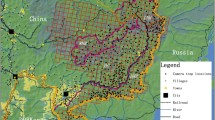Abstract
This is the first study presenting data on kill rates and food consumption among Asian leopardsPanthera pardus Linnaeus, 1758. In Bardia National Park, Nepal, we found leopard kills by searching within areas with clusters of locations from radio collared leopards (2 males and 1 female with 2 cubs aged 4–9 months). We used two tracking schemes, 24-h intensive radio-tracking and daily monitoring, and we defined food consumption as the product of average prey live weight and proportion consumed. The three leopards consumed 89.2 kg of meat from five chitalAxis axis, one domestic dog and two birds during 19 days of 24-h intensive tracking, rendering an average (± SE) daily food intake of 4.7 ± 0.3 kgper capita. Twenty-five prey items (14 chital, one muntjacMuntiacus muntjak, four primates and six birds) were found during 180 days of daily monitoring of the female. All edible biomass was consumed in all kills, except for three chital, and the rate of kill consumption was positively related to the age of her cubs. The average daily food consumption of the female was 4.0 ± 0.3 kg/day, the kill rate (days/kill) including all prey categories was 5.6 ± 0.4 days, and the kill rate of ungulates was 10.6 ±0.7 days. Our food consumption estimates are higher than reported from arid African environments. We suggest that the high food consumption rate in our study is a consequence of a release from time-energy constraints due to high prey abundance.
Similar content being viewed by others
References
Ali S. and Ripley S. D. 1978. Handbook of the birds of India and Pakistan: together with those of Bangladesh, Nepal and Sri Lanka. Vol. 1. 2nd edition. Oxford University Press, Delhi: 1–444.
Bailey T. N. 1993. The African leopard. Columbia University Press, New York: 1–429.
Bothma J. du P. and le Riche E. A. N. 1986. Prey preference and hunting efficiency of the Kalahari Desert leopard. [In: Cats of the world: Biology, conservation and management S. D. Miller SD and D. D. Everett, eds]. National Wildlife Federation, Washington DC: 381–414.
Bothma J. du P., Knight M. H., le Riche, E. A. N. and van Hensbergen H. J. 1997. Range size of southern Kalahari leopards. South African Journal of Wildlife Research 27(3): 94–99.
Dinerstein E. 1980. An ecological survey of the Royal Karnali-Bardia Wildlife Reserve, Nepal. Part III: Ungulate populations. Biological Conservation 18: 5–37.
Emmons L. H. 1987. Comparative feeding ecology of felids in a Neotropical rainforest. Behavioral Ecology and Sociobiology 20: 271–283.
Fleagle J. G. 1988. Primate adaptation and evolution. Academic Press, San Diego: 1–486.
Gittleman J. L. and Harvey P. H. 1982. Carnivore home range size, metabolic needs and ecology. Behavioral Ecology and Sociobiology 10: 57–63.
Hayward M. W., Henschel P., O’Brien J., Hofmeyr M., Balme G. and Kerley G. I. H. 2006. Prey preferences of the leopard (Panthera pardus). Journal of Zoology, London 270: 298–313.
Heinen J. T. and Kattel B. 1992. Parks, people and conservation: A review of management issues in Nepal’s protected areas. Population and Environment 14: 49–84.
Jeschke J. M. 2007. When carnivores are “full and lazy”. Oecologia 152: 357–364.
Karanth K. U., Nichols J. D., Kumar N. S., Link W. A. and Hines J. E. 2004. Tigers and their prey: Predicting carnivore densities from prey abundance. Proceedings of the National Academy of Sciences 14: 4854–4858.
Karanth K. U. and Sunquist M. E. 1995. Prey selection by tiger, leopard and dhole in tropical forests. Journal of Animal Ecology 64: 439–450.
Laundré J. W. 2005. Puma energetics: a recalculation. The Journal of Wildlife Management 69: 723–732.
Odden M. and Wegge P. 2005. Spacing and activity patterns of leopards Panthera pardus in Royal Bardia National Park, Nepal. Wildlife Biology 11: 145–152.
Schaller G. B. 1967. The deer and the tiger. University of Chicago Press, Chicago: 1–370.
Stander P. E. P., Haden J., Kaqece // and Ghau // 1997. The ecology of asociality in Namibian leopards. Journal of Zoology, London 242: 343–364.
Støen O. G. and Wegge P. 1996. Prey selection and prey removal by tiger (Panthera tigris) in lowland Nepal. Mammalia 60: 363–373.
Thompson S. K. 1992. Sampling. Wiley and Sons, New York: 1–343.
Wegge P., Odden M., Pokharel C. P. and Storaas T. (in press). Predator-prey relationships and responses of ungulates and their predators to the establishment of protected areas: A case study of tigers leopards and their prey in Bardia National Park, Nepal. Biological Conservation.
Wegge P., Pokheral C. P. and Jnawali S. R. 2004. Effects of trapping effort and trap shyness on estimates of tiger abundance from camera trap studies. Animal Conservation 7: 251–256.
Wilson E. O. 1975. Sociobiology: the new synthesis. Harvard University Press, Cambridge: 1–720.
Author information
Authors and Affiliations
Corresponding author
Additional information
Associate editor was Krzysztof Schmidt.
Rights and permissions
About this article
Cite this article
Odden, M., Wegge, P. Kill rates and food consumption of leopards in Bardia National Park, Nepal. Acta Theriol 54, 23–30 (2009). https://doi.org/10.1007/BF03193134
Received:
Accepted:
Published:
Issue Date:
DOI: https://doi.org/10.1007/BF03193134




